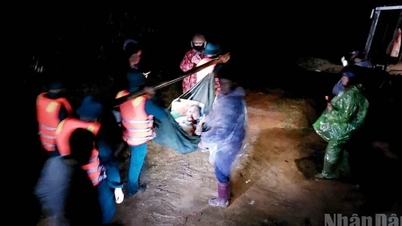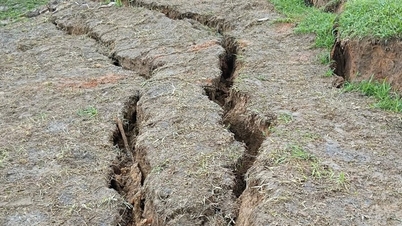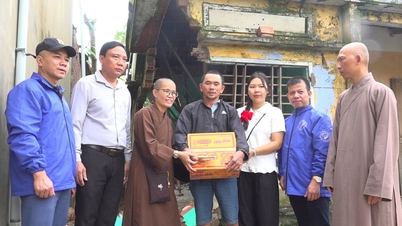The Cor people have a rich folk culture treasure, with many forms such as festivals, crafts, cuisine , performing arts, decoration, folk knowledge. The people have the custom of making poles and gu sets in festivals. A big festival with buffaloes must definitely have a pole (gak). The pole is considered the "ceremony stage", the center of the festival. All activities, rituals, and folk performances take place around the pole. Besides the pole, the Cor people also create and create some gu sets to hang in the middle of the living room to beautify the space of the traditional long house. The pole and gu sets are masterpieces of carving and decoration art of the Cor ethnic artisans.
 |
| The procession of the pole, the mascot of the Cor ethnic group. Photo: TV |
The Cor people created many different types of trees according to the form and scale of the buffalo-eating ceremony such as: buffalo-eating flagpole (xa glak), buffalo-eating upper flagpole (xa co), buffalo-eating flagpole xa coh, buffalo-eating leaf flagpole (xa xje), buffalo-eating flagpole cot kjá, buffalo-eating flagpole du (gâk đlu); buffalo-eating papaya flagpole (pa-lay du)... The upper flagpole (xa co) is similar to the flagpole but does not have the flagpole leaves, and has a swallow-bird on the top of the flagpole. The leaf-eating flagpole (xa xje) is made from the cho tree, cut down and left with the leaves intact, without carvings or patterns, and the top of the flagpole does not have the shape of a swallow-bird. The banana-heart flagpole (cot kjá) is the flagpole erected in the ancestor worship ceremony, about 6m high, the top of the flagpole has the shape of a banana heart pointing straight up to the sky, so it is called the banana-heart flagpole. The umbrella-shaped pole (gâk đlu) is a pole used in the buffalo-eating ceremony to ward off bad luck. It is 5m high, has a canopy like an umbrella, and has a sunbeam shape on top. This type of pole is only found in the Cor Duong Rung area (highlands).
The papaya tree (pa-lay du) is a tree built during the buffalo eating ceremony to pray for peace and fortune, about 4m high, with a sunbeam at the top, and near the top are wooden papayas carved. Among the types of trees, the flagpole (xa glak) is a round tree with decorative drawings, erected very high, about 15m. It is a decorative combination, consisting of three parts: base, trunk and top, connected together by a tenon joint connected to a bamboo tree reaching high into the sky. On top of the bamboo is bent down and hung a bamboo panel, called a flag panel with many decorative motifs. The people call it a flagpole because there is a flagpole hanging from the top of the tree, with a wooden image of a black-painted droning bird hanging on the top of the tree.
To decorate and beautify the festival space, the Cor people also create and create some gu sets to hang inside the long house. The Cor people choose put wood to make gu. This is an object of worship, an item to offer to the gods during the festival season and also a decorative item with high aesthetic value to beautify the living space. Not only does it have mysterious colors and patterns, each type of gu also has its own way of shaping, style, and decoration, making it a truly eye-catching highlight in the entire long house space. There are many different types of gu: gu bla, also known as round gu, hangs in the middle of the house; lavan is a flat gu, decorated on only one side, including gu mok a-tưl hung on the wall or above the front door frame of the long house, gu mok tum hung on the kitchen door, and gu tum hung in the kitchen. Gu bla is a very special type of gu, consisting of a gu trunk and 4 gu leaves creating 8 round gu ears built on four sides decorated with many unique patterns and motifs. Like other ethnic groups in the mountains, the kitchen loft of the Cor people is not only used to preserve food, food, and seeds, but also uses the color of kitchen smoke as a natural material for visual arts.
The gu set of the Cor people is made of put wood, which has soft wood grain and is very easy to carve. Before carving, people use soot and rau lang to create a black background on the gu body. The white patterns and drawings appear clearly on the black background of the wood. In addition, people also use two other colors: brick red from turmeric and areca nuts, and white from lime to highlight the patterns on the black background of the wood. Above the gu bla hangs a wooden eagle (sip trac). When performing ceremonies in the house, people often walk around the gu bla, like going around the pole in the yard. These are the two axes for arranging the mascots, where rituals and folk performances take place. The most sacred and impressive image is the shaman wearing a long dress and turban, holding a tray with a wax lamp and a group of people "receiving the ceremony" following clockwise and the graceful, swaying dance of the women.
With its meaning and beauty imbued with national identity, the Cor ethnic group's pole is displayed and restored in many places. However, this heritage is currently facing the risk of being lost over time. Therefore, it is necessary to organize festivals to restore the pole and pole creation competitions so that older artisans can teach the younger generation. In particular, poles such as flagpoles, banana-shaped poles, umbrella poles, and round poles - are artifacts of aesthetic value, the quintessence of the Cor ethnic group, and need to be collected and displayed in museums, village cultural houses, and introduced at ethnic cultural exchange festivals organized by the province and the central government.
With its aesthetic value and profound humanistic significance, on August 12, 2014, at the 7th meeting of the National Heritage Council, the art of decorating the pole and the gu of the Cor ethnic group in Bac Tra My district, Quang Nam province was recognized as a national intangible cultural heritage. After 10 years, on August 9, 2024, the Ministry of Culture, Sports and Tourism decided to include the art of decorating the pole of the Cor ethnic group in Tra Bong district, Quang Ngai province in the list of national intangible cultural heritage.
Source: https://baodanang.vn/channel/5433/202505/cay-neu-va-bo-gu-net-hoa-my-tren-vung-cao-son-nguyet-que-4007892/







![[Photo] Da Nang: Hundreds of people join hands to clean up a vital tourist route after storm No. 13](https://vphoto.vietnam.vn/thumb/1200x675/vietnam/resource/IMAGE/2025/11/07/1762491638903_image-3-1353-jpg.webp)
































































































Comment (0)